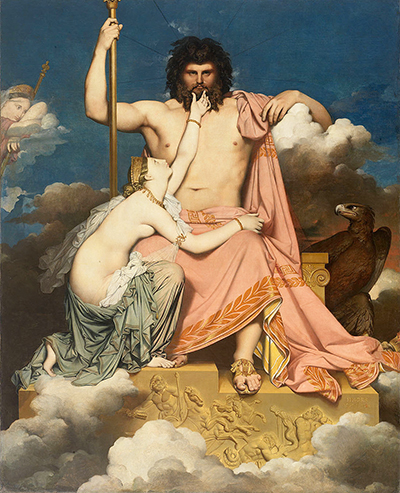Jupiter and Thetis was completed by Ingres in 1811 and now resides at the Musée Granet, Aix-en-Provence, France. This memorable scene received a mixed reception on its unveiling, somewhat depending on the region of Europe in which each critic derived from.
Some of the criticism around this painting was regarding the anatomical balance of the piece. Some felt that perhaps the limbs were a little too elongated, producing an unrealistic result. A close examination of the composition would suggest that perhaps they were referring to the female model's arms, which protrude slightly longer than you might normally expect. Others argued that the colour balance was too bright, with little contrasting of colours and shades. It would be wrong to say that all feedback was negative, though, with respected Dane, T.C. Bruun-Neergaard, writing that [Ingres] "...is very well trained and is incontestably one of the young painters who holds out the most hope for the revival of the modern French school...", just shortly after seeing this painting in Rome.
Whilst struggling to receive acceptance from others, artist Ingres is known to have been particularly pleased with this final, completed work. He displayed it proudly in his studio for a number of years, too. Two of the key elements to his signature style are to be found here too - the natural curves of the female model plus also the dominant male figure from whom she attempts to draw some attention. The completed piece is a large 136⅝ × 101¼ inches and was naturally completed in oils, just as with all his other paintings. The tale of Iliad 1.500–502, inspiration for this artwork, proclaimed, "...She sank to the ground beside him, put her left arm round his knees, raised her right hand to touch his chin, and so made her petition to the Royal Son of Cronos..."
The Musée Granet, Aix-en-Provence, features a fine collection of paintings from a variety of notable names. Besides this classic artwork from Ingres, you will also find art from the likes of Paul Cezanne, Jacques Louis David, Theodore Gericault and François-Marius Granet. Additionally, there is also plenty of sculpture and architecture too enjoy too, making this venue an excellent location to learn more about art history, with a particular bias towards French art. Aix-en-Provence itself is a small town in the south of France, located fairly close to the larger city of Marseille.




